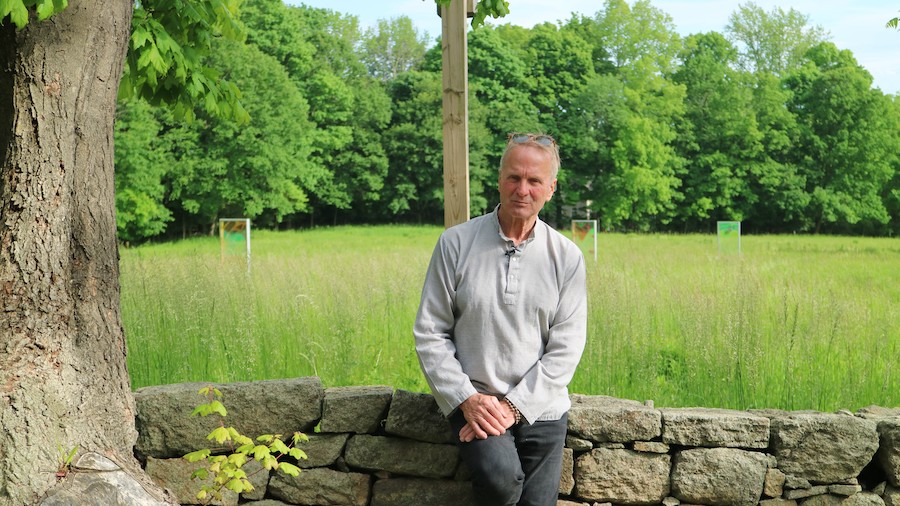It was in 2008-09 at St. Paul’s on the Green, an Episcopal church in Norwalk, that the artist Thomas S. Berntsen came to what he calls “a pivotal moment” in his life as he walked the labyrinth at the church.
“I found myself in the center and was struck by what my next step would be,” he says.
Berntsen — a former commercial architectural photographer in Manhattan whose art plays in the space between two and three dimensions — has always been fascinated by prehistoric cultures and labyrinths, those circular paths whose expression in prehistoric caves, ancient Greece and medieval cathedrals has led to modern, meditative designs.
Years before his revelatory moment at St. Paul’s, Berntsen had seen the labyrinth that decorates a portion of the floor at Chartres Cathedral in France. He was fascinated by its singularity, which he says makes a labyrinth different from a maze, with its multidirectional designs.
“A maze is designed to deceive you. A labyrinth is a single path covering lots of distance, filled with twists and turns, but it is a single path — your path.”
After his experience at St. Paul’s, Berntsen knew his path. He went home — he lives in Norwalk’s historic Silvermine district — and designed a labyrinthine sculpture made of wood and stone, which he torched, patinated and stained.
“It was the sign of the direction of my life,” he says.
Berntsen’s “Passages” — a series of seven 8-foot-tall panels that meander along a path in the central meadow of New Canaan’s Hannan-Eberstadt Preserve — is not a labyrinth per se but a labyrinth-inspired passageway, one that he and others hope will lead to better times for viewers and everyone else.
“It was important for us to install this signature piece as a hopeful reminder of better days ahead and to show the essential connection between art and nature,” Aaron Lefland, New Canaan Land Trust executive director, has said in a statement. “We believe that ‘Passages’ will serve as an inspiration to the entire community in the weeks and months to come.”
“Passages” is the first in a series of eight juried works for the new New Canaan Sculpture Trail, a partnership between the land trust and the Carriage Barn Arts Center that will see sculptures positioned at such land trust preserves as Hannan-Eberstadt, New Canaan Town Hall and the courtyard of the Carriage Barn at Waveny Park by summer. Berntsen’s work — which he made in three months after being selected based on a photograph of maquettes of the project he submitted in January—debuted in time to mark the 50th anniversary of Earth Day, April 22.
“Each panel is a signpost marking a passageway in (the Hannan-Eberstadt Preserve’s) meadow,” Berntsen says. And each consists of a steel frame covered with an acrylic on one side. On the other is warm dichroic film — a color-shifting, refractive film with overtones of blue and green, the colors of the sky and earth — that reproduces portions of the labyrinth design for Chartres Cathedral.
The work, then, is reflexive and reflective, playing not only with two and three dimensions but with the idea of going out to go deep inside. The viewer sees himself in these panels and then the world around him, says Berntsen, who describes himself not as a sculptor but as an artist who sculpts. It’s not until the viewer sees the world around him that he can begin to contemplate himself.
How he sees himself, the work and that world will depend on the time of day and weather. “Passages” functions as a collection of mirrors. Once when Berntsen was at Storm King Art Center in Mountainville with his girlfriend, the ceramicist Debbie Smith, he watched a group of children frolicking amid Alyson Shotz’s “Mirror Fence.”
“That’s what I want to do with my work,” he told her.
At other times, however, “Passages” is a kind of camouflage, blending into the landscape, disappearing like a ghost, he says.
It’s not surprising that Berntsen should use dichroic film, which has many architectural applications, in his work. Growing up in Rye, he wanted to be an architect but also loved photography. After getting a good technical grounding at the Rochester Institute of Technology, he became a commercial architectural photographer. In the late 1990s, a thorny assignment led to some soul-searching. And then came 9/11. He began photographing dead leaves for a series that he called “Dancing Leaves.”
Ultimately, there came another moment, one in which two dimensions were no longer enough. And then there were those labyrinths. He’s still passionate about them. Indeed, no sooner had he finished with “Passages” than he began work on another 8-foot-tall sculpture inspired by the Chartres labyrinth.
Like many of us, Berntsen sees in this moment of crisis a reflection of 9/11. For him, it was the time in which he shifted from commercial to fine art photography. And something else.
“I came to a moment when I no longer wanted to rail out at the world but bring it beauty and joy.”
For more, visit tsberntsen.com and newcanaanlandtrust.org.





